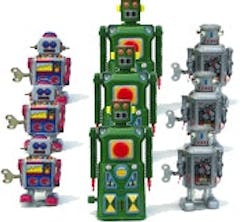You've Come a Long Way, Robobaby
As the industrial robot celebrates its 50th anniversary, there are some things that haven't changed much. The first robot (a Unimate) was sold in 1961 to General Motors, and today it is still the automotive industry that dominates the market for robot applications, much of it still the hot and heavy welding operations. The automotive industry remains the key driver for continued growth, where demand is increasing for facility renewal, according to Åke Lindqvist, president of the International Federation of Robotics (IFR, www.ifr.org) and this year's winner of the Engelberger Robotics Award.
But the robot has matured considerably over the past 50 years as well—its arms have evolved from hydraulics to electric servos, and applications continue to grow into a much wider array, with electronics production running a close second behind automotive. High-speed handling and pick-and-place operations are increasing, particularly in the food and pharmaceutical industries, noted Lindqvist, who spoke during a panel discussion at the recent Automate 2011 show in Chicago. "The level of automation is fairly low still, especially in food, but it's growing very rapidly," he added.
Technological improvements have included increasing safety, flexibility, accuracy, ease of use, and speed, improved communications, and the use of less space and energy consumption. It has been the merging of several technologies that enables robots to work in a variety of new environments such as food and pharmaceutical, said Kevin Ostby, vice president of Fanuc Robotics America (www.fanucrobotics.com), who spoke among the panel of robotics experts. "High-speed vision, high-speed line tracking, high-speed robots, and communication systems have really assisted implementation of robots in that market space."
The technology that has had one of the most profound effects on the industrial robot's development over the years has been machine vision, according to the panelists. Lindqvist, who recently retired from ABB Robotics after 37 years in the industry, recalled that ABB's management was convinced in the early 1980s that they should integrate vision with robots. "But we're just kind of getting into it now," he said, noting that cost has been a key preventive. Integrated vision, however, can change robotics dramatically, Lindqvist added.
"Vision really enables you to solve applications that you couldn't solve before," said John Dulchinos, CEO of Adept (www.adept.com), adding that any application that requires bringing product to a robot is well-served by vision. Asked why machine vision wasn't implemented on a broader scale earlier, Dulchinos explained that the exponential curve of computational capabilities in electronics over recent years enabled what is a very computation-intensive activity. "Vision has been able to take advantage of that technology."
But as some panelists noted, vision won't be the right technology for every application. A vision system is just one of many types of sensors, noted Stu Shepherd, president of Kuka America (www.kuka-systems.com). Vision is good for checking and adjusting tolerances, and for production lines on which parts are not exactly repeatable, added Michael Wenzel, CEO of Reis Robotics (www.reisrobotics.de). If the robot already knows exactly where and what the part should be, there is little need for vision capabilities.
Panelists and audience members alike still were excited about a joint presentation earlier that morning from NASA and General Motors, which collaborated to develop Robonaut 2, the first human-like robot in space. In particular, discussion focused on the flexibility of having two arms, and hand-like extensions to the arms.
"Robonaut is a spectacular demonstration of a whole multitude of technologies," Dulchinos said. "But one of the most expensive things is the hand. Getting it to a point of cost and reliability is going to be a real challenge."
The question is whether a hand-like extension is the best solution for most applications. As Dulchinos put it, human hands are more often than not fairly useless without tools in them. So in many cases, the tools themselves would be the more effective extension. "A lot of times, hands don't bring a lot of value to the application itself," Dulchino said.
Masahiro Ogawa, chairman of Yaskawa America (www.yaskawa.com), added that people seem to think fingers with opposable thumbs are what's needed for gripping. "But a human doesn't use five fingers always," he said, while picking up a pitcher of water with two open hands.
As robots continue to grow, developers will contemplate which technologies make sense for which uses, looking for new applications to tackle.


